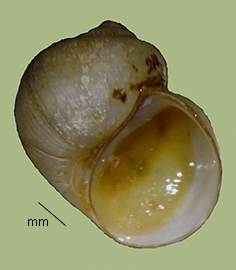> Habitat & Distribution
Thompson (1984) mapped at least 50 - 60 well-documented records of B. subglobosa, giving the range of the species as "widely distributed in the central United States from Wisconsin, Michigan ad Ohio south to Arkansas and Alabama, also in the Mohawk and Hudson Rivers sytems of New York." In our study area, we find populations commonly in the main Ohio River and scattered (usually direct) tributaries, such as the Wabash, Kentucky, and Licking Rivers. We are also aware of an apparently disjunct population of Birgella in the main Tennessee River as it traverses North Alabama.
Some populations of B. subglobosa inhabit soft, even silty bottoms, but our experience in the Ohio River and other navigable waterways suggests an association with hard substrate, possibly because of disruption by barge wake. FWGNA incidence rank I-4.
> Ecology & Life History
Berry (1943) characterized B. subglobosa as a "deep water inhabitant" in Michigan. But populations are not uncommonly observed in the shallows of the Ohio River and other large rivers further south.
Hydrobiids seem to be rather nonspecific grazers of small particles (Dillon 2000: 94-97). They are typically dioecious, the males being characterized by a penis that arises from the neck. Females attach single eggs in spare, hemispherical capsules to solid substrates (Hershler 1994).
> Taxonomy & Systematics
Baker (1926, 1928) described the genus Birgella to distinguish the (relatively larger) subglobosa from several dozen smaller species in the genus Somatogyrus, noting as he did minor differences in radula and verge. But he retained Birgella in the subfamily Lithoglyphinae, which (in more recent days) has been raised to the full family rank. Although the penis is, in overall aspect, simple and lithoglyphine, Thompson (1979, 1984) transferred Birgella to the subfamily Nymphophilinae, which today remains in the Hydrobiidae (ss). The CO1 sequence of an individual B. subglobosa from the Tennessee River in North Alabama was obtained by Hershler, Thompson & Liu (2011).
> Maps and Supplementary Resources
- Birgella distribution in the drainage of The Ohio (2019)
- Birgella in the Tennessee/Cumberland (2022)
> Essays
- Earlier versions of this website, online until August of 2016, adopted the large, broadly-inclusive concept of the Hydrobiidae (sl) following Kabat & Hershler (1993). More recently the FWGNA project has shifted to the Wilke et al. (2013) classification system, distinguishing a much smaller Hydrobiidae (ss) and elevating many hydrobioid taxa previously ranked as subfamilies to the full family level. For more details, see The Classification of the Hydrobioids.
> References
Berry, E. G. (1943) The
Amnicolidae of Michigan: Distribution, ecology, and taxonomy. Misc.
Publ. Mus. Zool. Univ. Mich. 57: 1 - 68.
Baker, F. C. (1926)
Nomenclatural
notes on American freshwater Mollusca. Transactions of the
Wisconsin Academy of Arts, Sciences, and Letters 22: 193 - 205.
Baker, F. C. (1928) The
Freshwater Mollusca of Wisconsin: Gastropoda. Bulletin of the
Wisconsin Geological and Natural History Survey 70: 1 - 507.
Hershler, R., F.G.
Thompson & H-P. Liu (2011) A large range
extension and molecular phylogenetic analysis of the monotypic North
American aquatic gastropod genus Cincinnatia
(Hydrobiidae). J. Moll. Stud. 77: 232 - 240.
Kabat, A.R., and R.
Hershler (1993)
The prosobranch snail family Hydrobiidae (Gastropoda: Rissooidea):
review of classification and supraspecific taxa. Smithsonian
Contributions to Zoology 547:1-94.
Thompson, F.G. (1979) The
systematic relationships of the hydrobioid snail genus Nymphophilus Taylor
1966 and the status of the Subfamily Nymphophilinae. Malac.
Rev. 12: 41 - 49.
Thompson, F.G. (1984) North
American freshwater snail genera of the hydrobiid subfamily
Lithoglyphinae. Malacologia 25: 109 - 141.
Wilke T., Haase M., Hershler R.,
Liu H-P., Misof
B., Ponder W. (2013)
Pushing short DNA
fragments to the limit: Phylogenetic relationships of hydrobioid
gastropods
(Caenogastropoda: Rissooidea). Molecular
Phylogenetics and Evolution 66: 715 736.








